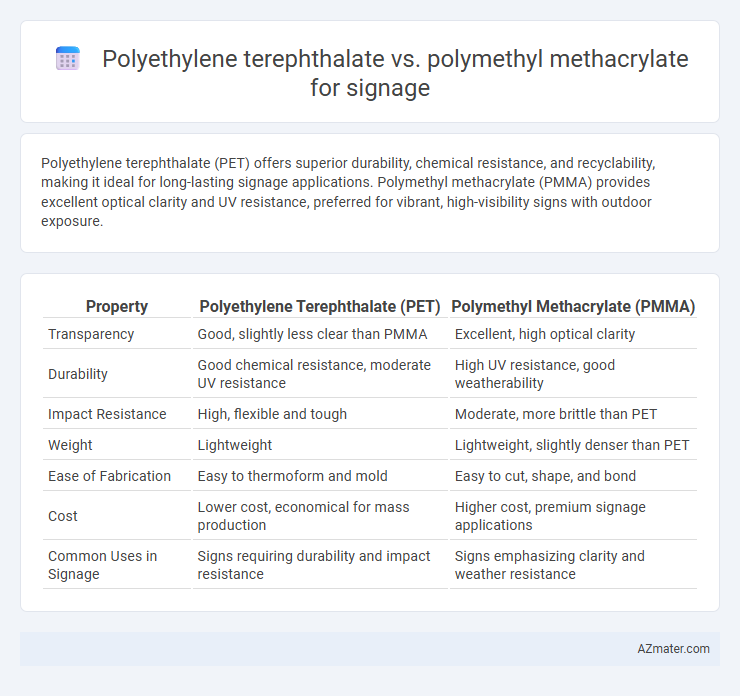Polyethylene terephthalate (PET) offers superior durability, chemical resistance, and recyclability, making it ideal for long-lasting signage applications. Polymethyl methacrylate (PMMA) provides excellent optical clarity and UV resistance, preferred for vibrant, high-visibility signs with outdoor exposure.
Table of Comparison
| Property | Polyethylene Terephthalate (PET) | Polymethyl Methacrylate (PMMA) |
|---|---|---|
| Transparency | Good, slightly less clear than PMMA | Excellent, high optical clarity |
| Durability | Good chemical resistance, moderate UV resistance | High UV resistance, good weatherability |
| Impact Resistance | High, flexible and tough | Moderate, more brittle than PET |
| Weight | Lightweight | Lightweight, slightly denser than PET |
| Ease of Fabrication | Easy to thermoform and mold | Easy to cut, shape, and bond |
| Cost | Lower cost, economical for mass production | Higher cost, premium signage applications |
| Common Uses in Signage | Signs requiring durability and impact resistance | Signs emphasizing clarity and weather resistance |
Introduction to PET and PMMA in Signage
Polyethylene terephthalate (PET) is a durable, lightweight thermoplastic widely used in signage for its excellent clarity, impact resistance, and recyclability. Polymethyl methacrylate (PMMA), also known as acrylic, offers superior optical clarity and UV resistance, making it a preferred choice for outdoor and illuminated signs. Both materials provide distinct advantages, with PET excelling in flexibility and cost-effectiveness, while PMMA delivers enhanced weatherability and aesthetic appeal.
Material Composition and Properties
Polyethylene terephthalate (PET) is a thermoplastic polymer known for its excellent strength, chemical resistance, and clarity, making it suitable for durable and lightweight signage. Polymethyl methacrylate (PMMA), or acrylic, offers superior optical clarity, UV resistance, and weatherability, enhancing outdoor signage visibility and longevity. While PET provides greater impact resistance and recyclability, PMMA excels in rigidity and surface hardness, influencing the choice based on environmental exposure and design requirements.
Visual Clarity and Aesthetics
Polyethylene terephthalate (PET) offers high optical clarity with excellent light transmission, making it suitable for vibrant signage that requires durability and impact resistance. Polymethyl methacrylate (PMMA), commonly known as acrylic, provides superior brilliance and glossy aesthetics with greater resistance to UV and yellowing, ensuring long-lasting visual appeal in outdoor and indoor signage. While PET excels in toughness and flexibility, PMMA stands out for its premium clarity and sleek finish, often preferred for high-end displays where aesthetic quality is paramount.
Durability and Weather Resistance
Polyethylene terephthalate (PET) offers excellent impact resistance and UV stability, making it highly durable for outdoor signage applications. Polymethyl methacrylate (PMMA), known for its superior clarity and weather resistance, withstands prolonged exposure to sunlight without yellowing or becoming brittle. While PET provides flexibility and toughness, PMMA delivers enhanced resistance to moisture, UV rays, and temperature fluctuations, ensuring long-lasting signage performance in harsh environments.
Weight and Handling Considerations
Polyethylene terephthalate (PET) offers a significantly lighter weight compared to Polymethyl methacrylate (PMMA), making it easier to handle during installation and transportation. PET's flexibility reduces the risk of cracks or breakage under stress, while PMMA is more rigid but prone to shattering under impact. For signage applications requiring frequent adjustments or portability, PET provides superior maneuverability without compromising durability.
Fabrication and Machinability
Polyethylene terephthalate (PET) offers excellent machinability with high impact resistance and flexibility, making it suitable for intricate signage fabrication processes such as thermoforming and laser cutting. Polymethyl methacrylate (PMMA), though rigid and providing superior optical clarity, requires careful machining to avoid cracking and is often processed through CNC routing and flame polishing to achieve smooth edges. Both materials support various fabrication techniques, but PET's durability and ease of thermoforming make it preferable for complex shapes, while PMMA excels where optical clarity and surface finish are paramount.
Cost Comparison for Signage Projects
Polyethylene terephthalate (PET) generally costs less than polymethyl methacrylate (PMMA) for signage projects, making PET a budget-friendly option for large-scale or temporary installations. PMMA offers superior clarity and weather resistance but comes at a higher price, which increases the overall project cost, especially for premium or long-term signage. Evaluating the balance between initial material cost and durability is crucial for cost-effective signage solutions.
Environmental Impact and Recyclability
Polyethylene terephthalate (PET) offers superior recyclability compared to Polymethyl methacrylate (PMMA), as PET is widely accepted in recycling programs and can be remanufactured into new products with reduced environmental impact. PMMA, although durable and resistant to UV degradation, poses challenges in recycling due to limited processing facilities and the release of potentially harmful compounds during disposal. Choosing PET for signage applications supports sustainable practices by minimizing landfill waste and lowering the carbon footprint associated with material production and end-of-life management.
Ideal Applications in Signage
Polyethylene terephthalate (PET) offers excellent durability and chemical resistance, making it ideal for outdoor signage exposed to harsh weather conditions and UV light. Polymethyl methacrylate (PMMA), known for its superior optical clarity and light transmission, is preferred for backlit signs, illuminated displays, and high-visibility indoor signage. Both materials provide distinct advantages, with PET favored for robustness and PMMA chosen for aesthetic brilliance in signage applications.
Summary: Choosing Between PET and PMMA for Signage
Polyethylene terephthalate (PET) offers cost-effective durability and excellent impact resistance for signage, making it ideal for outdoor and high-traffic environments. Polymethyl methacrylate (PMMA), known for superior optical clarity and UV resistance, provides a premium appearance with better weathering performance. Selecting between PET and PMMA depends on balancing budget constraints with desired visual quality and longevity requirements for specific signage applications.

Infographic: Polyethylene terephthalate vs Polymethyl methacrylate for Signage
 azmater.com
azmater.com